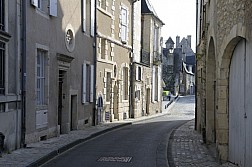
Narrow winding streets lead from the quay through the town where there are numerous old houses dating from the 14th to the 17th century.
Nevers first enters written history as Noviodunum, a town held by the Aedui at Roman contact. The quantities of medals and other Roman antiquities found on the site indicate the importance of the place, and in 52 BCE, Julius Caesar made Noviodunum, which he describes as in a convenient position on the banks of the Loire, a depot (B. G. vii. 55). There he had his hostages, corn, his military chest, with the money in it allowed him from home for the war, his own and his army’s baggage and a great number of horses which had been bought for him in Spain and Italy. After his failure before Gergovia, the Aedui at Noviodunum massacred those who were there to look after stores, the negotiators, and the travelers who were in the place. They divided the money and the horses among themselves, carried off in boats all the corn that they could, and burned the rest or threw it into the river. Thinking they could not hold the town, they burned it. This was a great loss to Caesar; and it may seem that he was imprudent in leaving such great stores in the power of treacherous allies. But he was in straits during this year, and probably he could not have done other than he did. Dio Cassius (xl. 38) tells the story of Caesar out of the affair of Noviodunum. He states incorrectly what Caesar did on the occasion, and he shows that he neither understood his original nor knew what he was writing about. The city was later called Nevirnum, as the name appears in the Antonine Itinerary. In the Tabula Peutingeriana, it is corrupted into Ebrinum. In still other sources the name appears as Nebirnum. It became the seat of a bishopric at the end of the 5th century. The county dates at least from the beginning of the 10th century. The citizens of Nevers obtained charters in 1194 and in 1231. For a short time in the 14th century the town was the seat of a university, transferred from Orléans, to which it was restored.
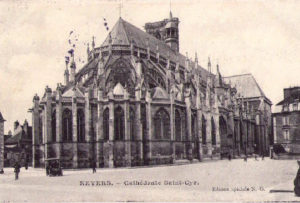 Among the ecclesiastical buildings the most important is the Cathédrale of Saint Cyr-Sainte Juliette, dedicated to Saint Quiricus and Saint Julietta, which is a combination of two buildings, and possesses two apses. The apse and transept at the west end are the remains of a Romanesque church, while the nave and eastern apse are in the Gothic style and belong to the 14th century. There is no transept at the eastern end. The lateral portal on the south side belongs to the late 15th century; the massive and elaborately decorated tower which rises beside it to the early 16th century.
Among the ecclesiastical buildings the most important is the Cathédrale of Saint Cyr-Sainte Juliette, dedicated to Saint Quiricus and Saint Julietta, which is a combination of two buildings, and possesses two apses. The apse and transept at the west end are the remains of a Romanesque church, while the nave and eastern apse are in the Gothic style and belong to the 14th century. There is no transept at the eastern end. The lateral portal on the south side belongs to the late 15th century; the massive and elaborately decorated tower which rises beside it to the early 16th century.
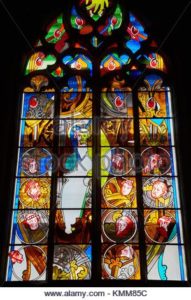
After 30 years of work, the stunning new stained glass windows in the Cathedral of St-Cyr-et-Ste-Juliette have been inaugurated. Contemporary in design, 130 picture windows have been created, costing 7.1 million euros. Jean-Michel Alberola, Gottfried Honnegaer, François Rouan, Raoul Ubac and Claude Viallat designed the new windows and worked in conjunction with master stained glass craftsmen. The original windows in the cathedral were destroyed in the bombing on the night of July 15-16 1944. The allied forces missed their target, a marshalling yard at Nevers railway station, showering the city with bombs and killing 162 inhabitants of the town. Three of the bombs exploded in the cathedral.
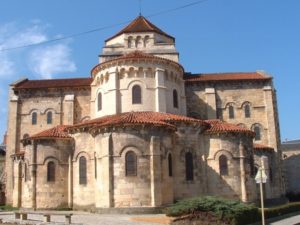
The Eglise Saint-Étienne de Nevers is a specimen of the Romanesque style of Auvergne of which the disposition of the apse with its three radiating chapels is characteristic. It was consecrated at the close of the 9th century, and belonged to a priory affiliated to Cluny.
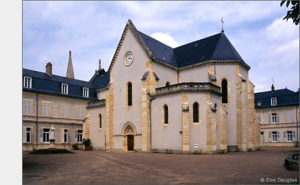
Nevers is also a place of pilgrimage. Bernadette Soubirous, a simple country girl from Lourdes claimed that the Virgin appeared 18 times to her. Several miracles occurred as a result of this and Lourdes then became a famous place for pilgrims. Persuaded of her calling, she became a nun at St. Gildard, a convent of the Sisters of Charity of Nevers. She died there in 1879, was beatified and later canonised in 1933. Her body has lain at the Espace Bernadette Soubirous , 34 Rue St-Gildard since 1925 and every year half a million people stop at the shrine. At the Chapel of Saint Bernadette at the mother house of the Sisters of Charity of Nevers, it is possible to view the incorrupt remains of Bernadette Soubirous (Saint Bernadette) which are presented in a gold and crystal reliquary. Nevers is also on the pilgrim route to Santiago de Compostela.
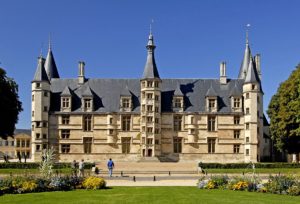
The Ducal Palace (now occupied by the courts of justice and an important ceramic museum) was built in the 15th and 16th centuries and is one of the principal feudal edifices in central France. The façade is flanked at each end by a turret and a round tower. A middle tower containing the great staircase has its windows adorned by sculptures relating to the history of the House of La Marck by the members of which the greater part of the palace was built.
Behind the palace lies an open space with a fine view over the valley of the Loire. The Porte du Croux, a square tower, with corner turrets, dating from the end of the 14th century, is among the remnants of the old fortifications; it now contains a collection of sculptures and Roman antiquities.
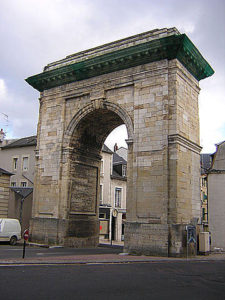
A triumphal arch built from 1742 to 1746 on the site of the old medieval gate of the Ardilliers.
This triumphal arch, the only one visible in the department of Nièvre, commemorates the victory of King Louis XV at the Battle of Fontenoy in 1745. In spite of the revolutionary amputations of the remarkable sculptures and coats of arms which were at its summit, this monument was classified as a historical monument in 1930.
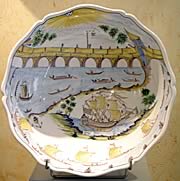
The history of Nevers, and in fact the whole of France can be traced through the pottery it is famous for, faïence. From Italian origins, this heavily patterned china depicts scenes from the ancien régime, to the Revolution in miniature on plates and ornaments. The Montagnon factory, Du Bout du Monde, founded in 1648, still carries on the traditions of generations. If you follow Le Fil Bleu, the blue line painted on the pavement from the Palais Ducal down Rue du 14 Juillet, it will lead you to the pottery quarter of town. Now a significant collection is on view at the Musée de la Faïence de Nevers in the beautifully renovated Abbaye de Notre Dame.
Economy
Nevers is the seat of a bishopric, of tribunals of first instance and of commerce and of a court of assizes and has a chamber of commerce and a branch of the Bank of France. Its educational institutions include several lycées, a training college for female teachers, ecclesiastical seminaries, a school of art of the automotive engineering college Institut supérieur de l’automobile et des transports. The town manufactures porcelain, agricultural implements, chemical manures, glue, boilers and iron goods, boots and shoes and fur garments, and has distilleries, tanneries and dye works. Its trade is in iron and steel, wood, wine, grain, livestock, etc. hydraulic lime, kaolin and clay for the manufacture of faience are worked in the vicinity.
Transport
The Gare de Nevers railway station offers connections to Paris, Dijon, Lyon, Clermont-Ferrand and several regional destinations. The A77 motorway connects Nevers with Paris.